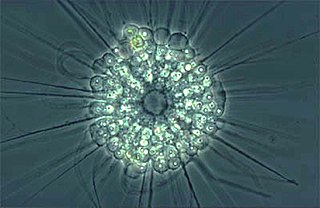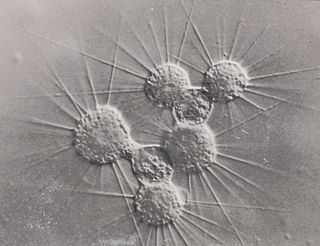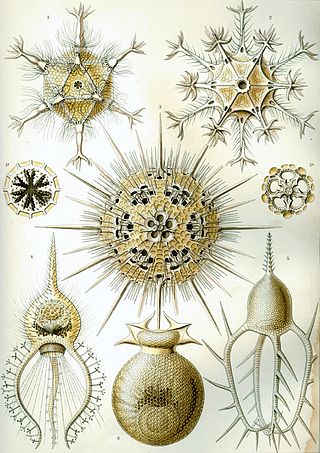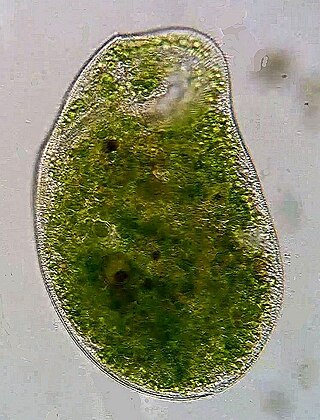
The actinophryids are an order of heliozoa, a polyphyletic array of stramenopiles, having a close relationship with pedinellids and Ciliophrys. They are common in fresh water and occasionally found in marine and soil habitats. Actinophryids are unicellular and roughly spherical in shape, with many axopodia that radiate outward from the cell body. Axopodia are a type of pseudopodia that are supported by hundreds of microtubules arranged in interlocking spirals and forming a needle-like internal structure or axoneme. Small granules, extrusomes, that lie under the membrane of the body and axopodia capture flagellates, ciliates and small metazoa that make contact with the arms.

Order Desmothoracida, the desmothoracids, are a group of heliozoan protists, usually sessile and found in freshwater environments. The adult is a spherical cell around 10-20 μm in diameter surrounded by a perforated organic lorica, or shell, with many radial pseudopods projecting through the holes to capture food. These are supported by small bundles of microtubules that arise near a point on the nuclear membrane. Unlike other heliozoans, the microtubules are not in any regular geometric array, there does not appear to be a microtubule organizing center, and there is no distinction between the outer and inner cytoplasm.
The gymnosphaerids are a small group of heliozoan protists found in marine environments. They tend to be roughly spherical with radially directed axopods, supported by microtubules in a triangular-hexagonal array arising from an amorphous central granule.

The centrohelids or centroheliozoa are a large group of heliozoan protists. They include both mobile and sessile forms, found in freshwater and marine environments, especially at some depth.

The Radiolaria, also called Radiozoa, are protozoa of diameter 0.1–0.2 mm that produce intricate mineral skeletons, typically with a central capsule dividing the cell into the inner and outer portions of endoplasm and ectoplasm. The elaborate mineral skeleton is usually made of silica. They are found as zooplankton throughout the global ocean. As zooplankton, radiolarians are primarily heterotrophic, but many have photosynthetic endosymbionts and are, therefore, considered mixotrophs. The skeletal remains of some types of radiolarians make up a large part of the cover of the ocean floor as siliceous ooze. Due to their rapid change as species and intricate skeletons, radiolarians represent an important diagnostic fossil found from the Cambrian onwards.

Pedinellales is a group of single-celled algae found in both marine environments and freshwater.

The axodines are a group of unicellular stramenopiles that includes silicoflagellate and rhizochromulinid algae, actinomonad heterotrophic flagellates and actinophryid heliozoa. Alternative classifications treat the dictyochophytes as heterokont algae, or as Chrysophyceae. Other overlapping taxonomic concepts include the Actinochrysophyceae, Actinochrysea or Dictyochophyceae sensu lato. The grouping was proposed on the basis of ultrastructural similarities, and is consistent with subsequent molecular comparisons.

Heliozoa, commonly known as sun-animalcules, are microbial eukaryotes (protists) with stiff arms (axopodia) radiating from their spherical bodies, which are responsible for their common name. The axopodia are microtubule-supported projections from the amoeboid cell body, and are variously used for capturing food, sensation, movement, and attachment. They are similar to Radiolaria, but they are distinguished from them by lacking central capsules and other complex skeletal elements, although some produce simple scales and spines. They may be found in both freshwater and marine environments.

Actinophrys is a genus of heliozoa, amoeboid unicellular organisms with many axopodial filaments that radiate out of their cell. It contains one of the most common heliozoan species, Actinophrys sol. It is classified within the monotypic family Actinophryidae.

Phaeodarea or Phaeodaria is a group of amoeboid cercozoan organisms. They are traditionally considered radiolarians, but in molecular trees do not appear to be close relatives of the other groups, and are instead placed among the Cercozoa. They are distinguished by the structure of their central capsule and by the presence of a phaeodium, an aggregate of waste particles within the cell.

Chaos is a genus of single-celled amoeboid organisms in the family Amoebidae. The largest and most-known species, the so-called "giant amoeba", can reach lengths up to 5 mm, although most specimens fall between 1 and 3 mm.

Spirostomum is a genus of ciliated protists in the class Heterotrichea. It is known for being very contractile. Having been first identified by Christian Gottfried Ehrenberg in 1834, further research has identified eight additional true morphospecies. This bacterivore genus mainly lives in the sediment deposits at the bottom of various aquatic habitats, and members possess rquA genes that could be responsible for their ability to survive in these hypoxic and anoxic environments. They are identifiable by their relatively large tubular/flat vermiform bodies. Their life cycle consists of a growth stage, in which they mature, and asexual and sexual reproduction stages. Some species are model organisms for studies on human pathogenic bacteria, while others are sensitive and accurate bioindicators for toxic substances.

Amoeba is a genus of single-celled amoeboids in the family Amoebidae. The type species of the genus is Amoeba proteus, a common freshwater organism, widely studied in classrooms and laboratories.

Raphidiophrys is a genus of centrohelid with radiating axopodia. R. intermedia is found in the bottom sludge of freshwater bodies in Canada, Chile, Argentina, Australia, New Zealand, Malaysia, Russia, and central Europe. Raphidiophrys have bipartite scales are a defining characteristic among species. Differences in type and size of scales are used to differentiate amongst the members of this genus. The genus Raphidiophrys was discovered in 1867 by W. Archer. Raphidiophrys is one of very few centrohelids in which dimorphism has been shown.

Raphidiophrys contractilis is a species of freshwater centrohelid.

Climacostomum virens is a species of unicellular ciliate protists. It is one of just two formally described species in the genus Climacostomum.

Raphidomonadea is a class of Stramenopiles containing both photosynthetic and phagotrophic protists. The phagotrophic groups are known as Raphopoda, and comprise actinophryid heliozoa and the marine genus Commation. The photosynthetic groups are known as the raphidophyte algae. Their relationship was elucidated through phylogenetic analyses.
Aurigamonas is a genus of predatory protists of an unusual cell structure, with two flagella and numerous haptopodia. It is a monotypic genus containing the single species Aurigamonas solis. It is the only genus of the family Aurigamonadidae.

Syssomonas is a monotypic genus of unicellular flagellated protists containing the species Syssomonas multiformis. It is a member of Pluriformea inside the lineage of Holozoa, a clade containing animals and their closest protistan relatives. It lives in freshwater habitats. It has a complex life cycle that includes unicellular amoeboid and flagellated phases, as well as multicellular aggregates, depending on the growth medium and nutritional state.
Heliorapha is a genus of heliozoan protists, amoeboid eukaryotes with stiff axopodia radiating from their cells. It contains one species, Heliorapha azurina. It is classified within a monotypic family Helioraphidae inside the actinophryids, a group of heliozoa that belong to the Ochrophyta along with other protists such as diatoms and brown algae.
















